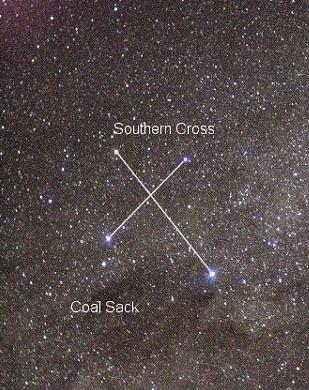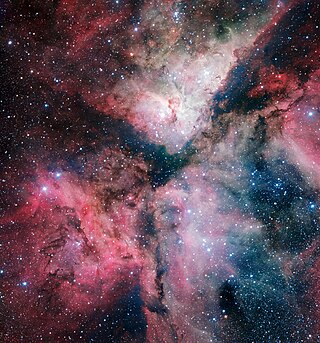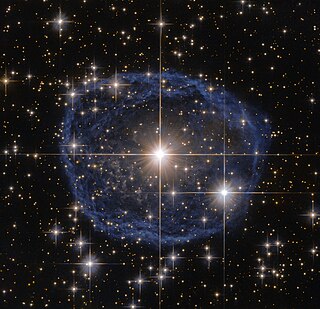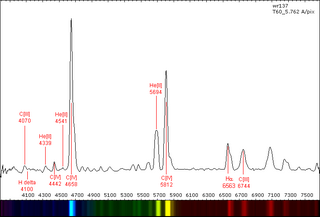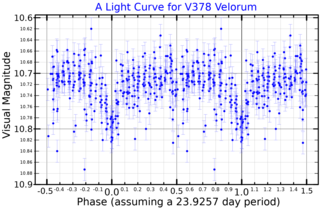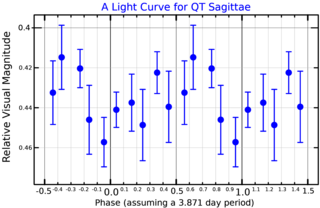 A visual band light curve for V863 Cassiopeiae, adapted from Chené et al. (2008). [1] The data were taken from November 2003 to February 2004, and different cycles are shown with different colors. | |
| Observation data Epoch J2000 Equinox J2000 | |
|---|---|
| Constellation | Cassiopeia |
| Right ascension | 00h 43m 28.39717s [2] |
| Declination | +64° 45′ 35.3847″ [2] |
| Apparent magnitude (V) | 10.54 [3] |
| Characteristics | |
| Evolutionary stage | Wolf-Rayet |
| Spectral type | WN4-s [4] |
| U−B color index | −0.24 [5] |
| B−V color index | +0.37 [5] |
| Variable type | WR [3] |
| Astrometry | |
| Proper motion (μ) | RA: −2.878 [2] mas/yr Dec.: −0.702 [2] mas/yr |
| Parallax (π) | 0.3092 ± 0.0139 mas [2] |
| Distance | 10,500 ± 500 ly (3,200 ± 100 pc) |
| Absolute magnitude (MV) | −4.9 [6] |
| Details | |
| Mass | 27 [4] M☉ |
| Radius | 2.26 [4] R☉ |
| Luminosity | 760,000 [4] L☉ |
| Temperature | 112,200 [4] K |
| Rotational velocity (v sin i) | 6.5 [7] km/s |
| Other designations | |
| Database references | |
| SIMBAD | data |
WR 1 is a Wolf-Rayet star located around 10,300 light years away from Earth in the constellation of Cassiopeia. It is only slightly more than twice the size of the sun, but due to a temperature over 100,000 K it is over 758,000 times as luminous as the sun.
Although WR 1 has been recognised as a Wolf-Rayet star since the 19th century, [8] the WR 1 designation does not indicate that it was the first to be discovered. Ordered by right ascension, WR 1 is the first star in the Seventh Catalogue of galactic Wolf-Rayet stars. [9]
WR 1 is a member of the nitrogen sequence of WR stars and has a spectrum with HeII lines much stronger than HeI lines, and NV emission more than twice the strength of NIII, leading to the assignment of a WN4 spectral type. The spectrum has particularly wide HeII, leading to the equivalent classifications of WN4-b (for broad) or WN4-s (for strong). The spectrum also includes CIV and NIV, but no hydrogen lines at all, [10] [11] indicating that WR 1 has already expelled all of its hydrogen through its powerful solar winds.
WR 1 is slightly variable and given the variable star designation V863 Cassiopeiae. The total amplitude of the variations is only 0.09 magnitudes at visual wavelengths. The variations are well-defined with a period of 16.9 days, but the light curve is not sinusoidal and its shape may vary. [12] The variations have been ascribed to a dense asymmetric stellar wind and co-rotating interacting regions in ejected material. [7]
It has been suggested that the variability and an infrared excess could be due to a cool companion, but WR 1 is now considered to be a single star. [11] The WN-b subclass of Wolf-Rayet star are generally thought to be all single, in contrast with the WN-A subclass which have narrow emission on a stronger continuum and are thought to be binary systems with a more conventional hot luminous star. [10]
WR 1 is a possible member of the Cassiopeia OB7 association [9] at a distance of around 1,800 pc , [4] although its Gaia parallax suggests it is more distant. [2] Interstellar extinction is calculated to be 2.1 magnitudes, and at 1,820 pc the bolometric luminosity would be 758,600 L☉. A temperature of 112,200 K is derived from fitting the spectrum, giving a radius of 2.26 R☉. [4]



